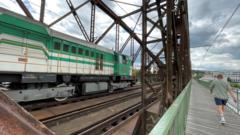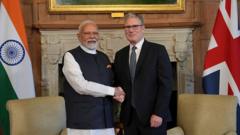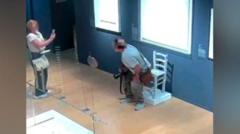As Prague prepares to replace the historic Vysehrad railway bridge, tensions rise between preservationists and transport authorities over the fate of this 123-year-old landmark. This striking steel structure, an icon of the city's skyline that has survived invasions and wars, is now at the center of a heated discussion about the balance between cultural heritage and modern transport requirements.
Prominent bridge engineer and architect, Petr Tej, passionately describes the Vysehrad bridge as essential to Prague’s identity, drawing parallels with the famous Charles Bridge and Prague Castle. He believes that the bridge, alongside the fortress it complements, forms a key panorama that reflects the city's rich architectural history. Tej is part of the Vysehrad Bridge Foundation, advocating for preservation. According to their studies, repair rather than replacement is not only viable but preferable—contradicting previous assessments suggesting extensive reconstruction.
The foundation posits that only 15% of the bridge requires replacement, a stark contrast to the Railway Authority's claims of 70% refurbishment needs. Unesco has recognized their preservation efforts, and over 25,000 locals have signed petitions in favor of restoration.
However, representatives from the Railway Authority maintain that the prospect of escalating rail traffic necessitates a new bridge. Pavel Paidar, a key figure in the authority, highlights the current structural limitations exacerbated by corrosion, arguing that to meet future demands, a new bridge with an added third line is essential. Authorities assert that while the bridge has historical value, modern transport needs cannot be overlooked.
The proposed replacement aims to reflect the original bridge’s design while improving transport links significantly. Yet, critics are skeptical about relocating the original bridge to Modrany. They assert that placing an urban railway structure in a pastoral setting would disrupt the area’s aesthetic and ecological balance.
Tomas Bistricky, philanthropist and co-founder of the Vysehrad Bridge Foundation, stresses the potential for harmony between rail infrastructure and heritage conservation. He argues that these interests are not at odds, but rather can enhance each other—a sentiment that resonates in a city deeply rooted in architectural preservation.
As this debate rages, the future of the Vysehrad rail bridge stands as a poignant reminder of the challenge faced globally: balancing the need for modern advancements against the imperative to preserve cultural symbols. Ultimately, the decision will hinge on the Czech government, who must navigate the passionate arguments from both sides.
Prominent bridge engineer and architect, Petr Tej, passionately describes the Vysehrad bridge as essential to Prague’s identity, drawing parallels with the famous Charles Bridge and Prague Castle. He believes that the bridge, alongside the fortress it complements, forms a key panorama that reflects the city's rich architectural history. Tej is part of the Vysehrad Bridge Foundation, advocating for preservation. According to their studies, repair rather than replacement is not only viable but preferable—contradicting previous assessments suggesting extensive reconstruction.
The foundation posits that only 15% of the bridge requires replacement, a stark contrast to the Railway Authority's claims of 70% refurbishment needs. Unesco has recognized their preservation efforts, and over 25,000 locals have signed petitions in favor of restoration.
However, representatives from the Railway Authority maintain that the prospect of escalating rail traffic necessitates a new bridge. Pavel Paidar, a key figure in the authority, highlights the current structural limitations exacerbated by corrosion, arguing that to meet future demands, a new bridge with an added third line is essential. Authorities assert that while the bridge has historical value, modern transport needs cannot be overlooked.
The proposed replacement aims to reflect the original bridge’s design while improving transport links significantly. Yet, critics are skeptical about relocating the original bridge to Modrany. They assert that placing an urban railway structure in a pastoral setting would disrupt the area’s aesthetic and ecological balance.
Tomas Bistricky, philanthropist and co-founder of the Vysehrad Bridge Foundation, stresses the potential for harmony between rail infrastructure and heritage conservation. He argues that these interests are not at odds, but rather can enhance each other—a sentiment that resonates in a city deeply rooted in architectural preservation.
As this debate rages, the future of the Vysehrad rail bridge stands as a poignant reminder of the challenge faced globally: balancing the need for modern advancements against the imperative to preserve cultural symbols. Ultimately, the decision will hinge on the Czech government, who must navigate the passionate arguments from both sides.





















